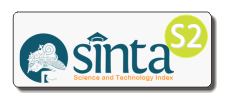Effectiveness of next generation science standards based 5e learning model by utilizing local potential
Dadan Rosana, Universitas Negeri Yogyakarta, Indonesia
Abstract
Keywords
Full Text:
Fulltext PDFReferences
Açışlı, S., Yalçın, S. A., & Turgut, Ü. (2011). Effects of the 5E learning model on students’ academic achievements in movement and force issues. Procedia - Social and Behavioral Sciences, 15, 2459–2462. https://doi.org/10.1016/j.sbspro.2011.04.128
Alshehri, M. A. (2016). The impact of using (5e’s) instructional model on achievement of mathematics and retention of learning among fifth grade students. IOSR Journal of Research & Method in Education (IOSR-JRME), 6(2), 43–48. https://doi.org/10.9790/7388-06214348
Bagno, E., & Eylon, B. (1997). From problem solving to a knowledge structure: An example from the domain of electromagnetism. American Journal of Physics, 65(8), 726–736. https://doi.org/10.1119/1.18642
Bybee, R. (2014). Guest editorial: The BSCS 5E instructional model: personal reflections and contemporary implications. Science and Children, 051(08). https://doi.org/10.2505/4/sc14_051_08_10
Bybee, R. W., Taylor, J. a, Gardner, A., Scotter, P. V, Powell, J. C., Westbrook, A., & Landes, N. (2006). The BSCS 5E instructional model: origins, effectiveness, and applications. Colorado Springs BSCS.
Carlgren, T. (2013). Communication, critical thinking, problem solving: A suggested course for all high school students in the 21st century. Interchange, 44(1–2), 63–81. https://doi.org/10.1007/s10780-013-9197-8
Dash, S., Kamath, U., Rao, G., Prakash, J., & Mishra, S. (2016). Audio-visual aid in teaching “fatty liver.” Biochemistry and Molecular Biology Education, 44(3), 241–245. https://doi.org/10.1002/bmb.20935
Gök, T., & Sýlay, I. (2010). The effects of problem solving strategies on students’ achievement, attitude and motivation. Latin-American Journal of Physics Education, 4(1). https://dialnet.unirioja.es/servlet/articulo?codigo=3694877
Hake, R. R. (1999). Analyzing change/Gain scores. http://www.physics.indiana.edu/~sdi/AnalyzingChange-Gain.pdf
Haviz, M., Karomah, H., Delfita, R., Umar, M. I. A., & Maris, I. M. (2018). Revisiting generic science skills as 21st century skills on biology learning. Jurnal Pendidikan IPA Indonesia, 7(3), 355–363. https://doi.org/10.15294/jpii.v7i3.12438
Krajcik, J., Codere, S., Dahsah, C., Bayer, R., & Mun, K. (2014). Planning instruction to meet the intent of the next generation science standards. Journal of Science Teacher Education, 25(2), 157–175. https://doi.org/10.1007/s10972-014-9383-2
Laurens, T., Laamena, C., & Matitaputty, C. (2014). Development a set of instructional learning based realistic mathematics education and local wisdom. Proceedings of International Seminar Innovation in Mathematics and Mathematics Education, 66, 571–576.
McComas, W. F. (2014). Framework for K-12 science education. In The Language of Science Education (pp. 41–41). SensePublishers. https://doi.org/10.1007/978-94-6209-497-0_38
McComas, W. F., & Nouri, N. (2016). The nature of science and the Next Generation Science Standards : Analysis and critique. Journal of Science Teacher Education, 27(5), 555–576. https://doi.org/10.1007/s10972-016-9474-3
Miller, M. D., Linn, R. L., & Gronlund, N. E. (2013). Measurement and assessment in teaching. Pearson.
Next Generation Science Standards. (2013). Next generation science standards. In Next Generation Science Standards: For States, By States (Vols. 1–2). National Academies Press. https://doi.org/10.17226/18290
Ohlsson, S. (2012). The problems with problem solving: reflections on the rise, current status, and possible future of a cognitive research paradigm. The Journal of Problem Solving, 5(1), 101–128. https://doi.org/10.7771/1932-6246.1144
Undang-Undang Republik Indonesia Nomor 32 Tahun 2009 tentang perlindungan dan pengelolaan lingkungan hidup, Pub. L. No. 32 (2009).
Pressman, A. (2019). Design thinking : a guide to creative problem solving for everyone. Routledge.
Purwanto, N., & Purwanto, M. N. (2006). Prinsip-prinsip dan teknik evaluasi pengajaran. Remaja Rosda Karya.
Ridsdale, C., Rothwell, J., Smit, M., Ali-Hassan, H., Bliemel, M., Irvine, D., Kelley, D., Matwin, S., & Wuetherick, B. (2015). Strategies and best practices for data literacy education. In Knowledge Synthesis Report (Issue January). https://doi.org/10.13140/RG.2.1.1922.5044
Rusyna, A. (2014). Keterampilan Berpikir. Ombak.
Sugiyono, S. (2015). Metode penelitian pendidikan: Pendekatan kuantitatif, kualitatif, dan R & D. Alfabeta.
Sya`ban, M. F., & Wilujeng, I. (2016). Pengembangan SSP zat dan energi berbasis keunggulan lokal untuk meningkatkan literasi sains dan kepedulian lingkungan. Jurnal Inovasi Pendidikan IPA, 2(1), 66–75. https://doi.org/10.21831/jipi.v2i1.8369
Temel, S., Yılmaz, A., & Özgür, S. D. (2013). Use of the learning cycle model in the teaching of chemical bonding and an investigation of diverse variables in prediction of achievement. International Journal of Education and Research, 1(5), 1–14. https://www.ijern.com/images/May-2013/26.pdf
Trianto, T. (2012). Mendesain model pembelajaran inovetif-progresif konsep, landasan dan implementasinya pada KTSP. Kencana.
Trilling, B., & Fadel, C. (2009). 21st century skills: Learning for life in our times. Jossey-Bass.
Tuna, A., & Kaçar, A. (2013). The effect of 5E learning cycle model in teaching trigonometry on students’ academic achievement and the permanence of their knowledge. International Journal on New Trends in Education and Their Implications, 4(1), 214. http://www.ijonte.org/FileUpload/ks63207/File/07.tuna.pdf
Türkmen, H. (2006). What technology plays supporting role in learning cycle approach for science education. The Turkish Online Journal of Educational Technology, 5(2), 71–76.
Türkmen, H., & Usta, E. (2007). The role of learning cycle approach overcoming misconceptions in science. Ekim Kastamonu Education Journal, 15(2), 491–500. http://www.kefdergi.com/pdf/15_2/hturkmen.pdf
Wilder, M., & Shuttleworth, P. (2005). Cell inquiry: A 5E learning cycle lesson. Science Activities: Classroom Projects and Curriculum Ideas, 41(4), 37–43. https://doi.org/10.3200/SATS.41.4.37-43
Wilujeng, I., Prasetya, Z. K., & Suryadarma, I. (2017). Science learning based on local potential: Overview of the nature of science (NoS) achieved. AIP Conference Proceedings, 080005. https://doi.org/10.1063/1.4995189
Zhou, Q. (2018). Research on scientific data literacy education system. Open Journal of Social Sciences, 06(06), 187–199. https://doi.org/10.4236/jss.2018.66017
DOI: https://doi.org/10.21831/jipi.v6i2.37445
Refbacks
- There are currently no refbacks.
Copyright (c) 2020 Jurnal Inovasi Pendidikan IPA

This work is licensed under a Creative Commons Attribution-ShareAlike 4.0 International License.
Jurnal Inovasi Pendidikan IPA indexed by:

Jurnal Inovasi Pendidikan IPA by http://journal.uny.ac.id/index.php/jipi/index is licensed under a Creative Commons Attribution-ShareAlike 4.0 International License.
All rights reserved. p-ISSN: 2406-9205 | e-ISSN: 2477-4820
View My Stats













